INTERESTING ASSORTED LEATHERLANDS
Here are some of the interesting Litherlands, Leatherlands and Letherlands I have discovered in my researches. Most of them do not have any direct links to my ancestors as far as I know - or the links have not been established - but they have interesting life stories.
John Leatherland : Diplomat in Constantinople
In 1982 a man from Oxford who used to work as a BBC producer wrote to my grandfather. He explained that among some family mementos, he had a leather pouch or wallet which was made in Constantinople in 1685 for John Leatherland. The pouch was inscribed with Leatherland's name. By family tradition he was reputed to have been a 'diplomat'. The English ambassador at that time was appointed by the Levant Company, but there was a four year gap at that time in their records in the Public Record Office, so it was not possible to establish whether the family legend was true.
He also had a large portrait ofa gentleman of a somewhat later date in an 'orientalised' headdress. The portrait was believed to be of John Leatherland. It was inherited from the Church family in Shropshire. The writer of the letter wondered whether he may have married one of the Church girls of Betton House, near Market Drayton, Shropshire.
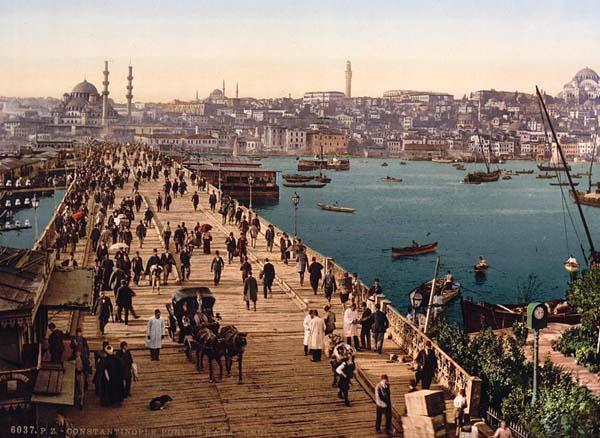
Constantinople
The portrait was large and formed a matching and facing pair with a portrait of William Church, a wealthy early 18th century landowner who built Tunstall Hall near Market Drayton, Shropshire in 1734. The Churches originally came from Nantwich, Cheshire but they had been settled in Shropshire since the 16th century. William Church inherited an immense area of property stretching south from Nantwich and Newcastle-under-Lyme to south of Market Drayton..
A great aunt of the writer from Oxford had inherited the portrait and leather pouch and his father jotted down what his aunt told him about the portrait and the fact that Leatherland was a diplomat.
The portrait showed John Leatherland with a dog and book. The portrait was a matching pair with a portrait of William Church which suggested that they had complimentary roles. It was suggested that John Leatherland might have been a sort of guardian to William Church, whose father died when he was a boy, and there was an immense estate to manage.
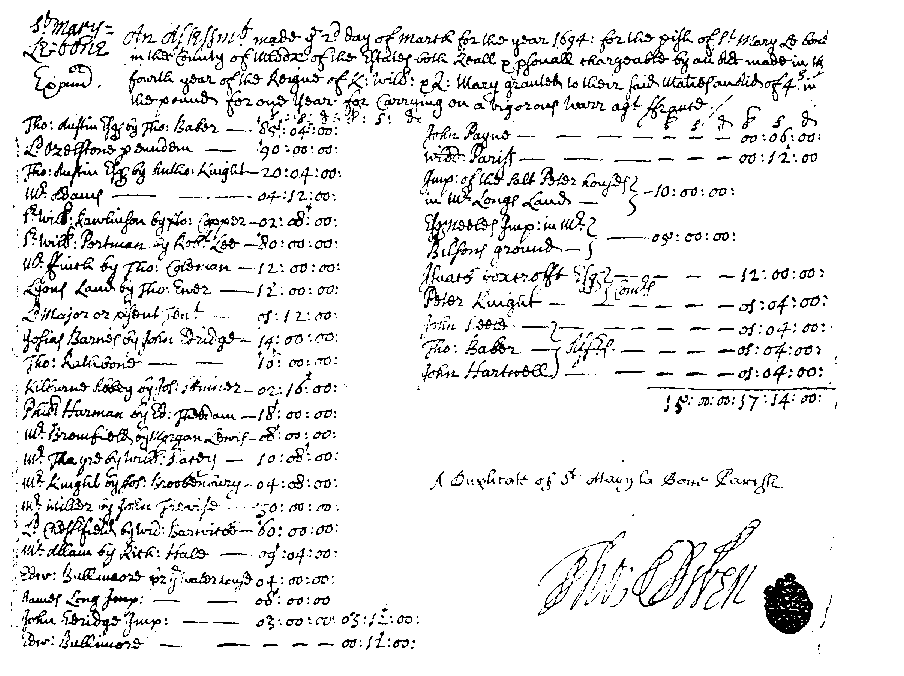
Part of an assessment of the Four Shillings in the Pound Aid for the parish of St. Marylebone (from the Centre for Metropolitan History website www.history.ac.uk/cmh/main)
There are two references to a John Leatherland in a data archive of the Four Shillings in the Pound Tax of 1693-4, a tax on real and personal property which was collected in order to finance the wars fought by King William between 1689 and 1697. The tax was levied at the rate of four shillings in every pound (20 %) on the rental value of all real property, income earned in public service, and stock or ready money held as part of a personal estate. Individuals whose real property was worth less than 20 shillings were exempt. The tax raised £296,160 in 1693 from the residents of London. The assessment of 1693 lists heads of households and wealthy lodgers, totalling 57,315 taxpayers, which was around 10 per cent of the total population of London, so it was a tax on the wealthy.
The data archive includes two Leatherlands :
- John Leatherland of the Farringdon Ward Within who paid 8 shillings fourpence on the rental value of Mr Leatherland's property, and 1 shilling tuppence on his personal property.
- John Letherland of White Cross Street in the St Giles Cripplegate Ward. He was a tenant and his landlord was named as Ralph Hardwick. 2 shillings was levied on the rental value of the property and none on his personal property.
Although I have no direct evidence that either of them are Leatherland the diplomat, it is likely that Mr Leatherland stayed in London from time to time so this is a distinct possibility.
This data is available on the www.londonlives.org website.
Dr Joseph Letherland 1699 - 1764 : Physician to the Queen
Dr Joseph Letherland was an eminent 18th century doctor who was physician to Queen Charlotte, wife of George III, between 1761 and 1764.
He studied at Leiden University in the Netherlands and gained a degree in Medicine in 1724. He was created Doctor of Medicine by royal mandate at Cambridge in 1736.
Letherland was a doctor at St Thomas's Hospital, London, from 1736 to 1758. He is reputed to have been the first doctor to draw attention to the disease of diptheria in 1739. He had a large library of books and, following his death in 1765, his library was sold. William Hudson, a physician and collector, bought 138 of his books (mainly medical and scientific works) for £139.
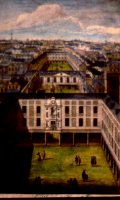
St Thomas' Hospital (18th century engraving) - the hospital used to be in Southwark near London Bridge
Dr Letherland was also a talented amateur mathematician and collected a substantial scientific library. The second book sale after his death in May 1765 included scientific instruments, curiosities and manuscripts included all the surviving editorial material for the third (and last lifetime) edition of Sir Isaac Newton's 'Principia' (1726) which was edited by his friend from Leiden, Henry Pemberton.
Berrow's Worcester Journal reported in April 1764 : "This Morning died, after a long and painful Illness, Dr. Letherland, Physician to her Majesty. This Gentleman was reputed to have as much useful Knowledge in every Branch of Literature as any Person in Europe."
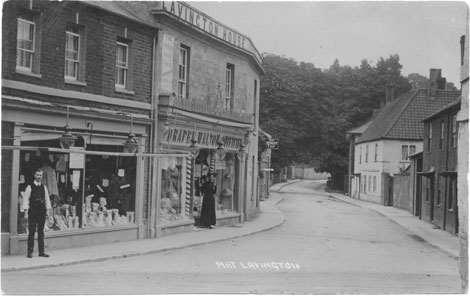
Market Lavington
Dr Letherland's brother, Stephen Letherland, was an apothecary and surgeon. In the National Archives index, I found a reference to a conveyance dated November 1766 in which Stephen Letherland of Market Lavington, Wiltshire, apothecary and surgeon - described as brother and heir to Joseph Letherland late of London, M.D. and the eldest son and heir of John Letherland of Stratford-upon-Avon, gentleman - transferred a property in Rother Street, Stratford upon Avon to Thomas Cookes of Stratford-upon-Avon, maltster. There are several other references to property documents relating to Stephen Letherland in the National Archives index.
The reference to Joseph and Stephen Letherland being the sons of John Leatherland leads to a slight possibility that their father was the diplomat referred to above, although I have no further evidence of this.
William Letherland : Journalist Who Died in a Train Crash
William Letherland's life ended tragically in a train crash. William was born in Nottinghamshire in 1842. He became a newspaper reporter and in the 1871 census he was staying in the Russell Street Imperial Hotel in Stroud, Gloucestershire perhaps covering a story. I understand that he may have been a reporter on the Northampton Mercury in the mid 1870s.
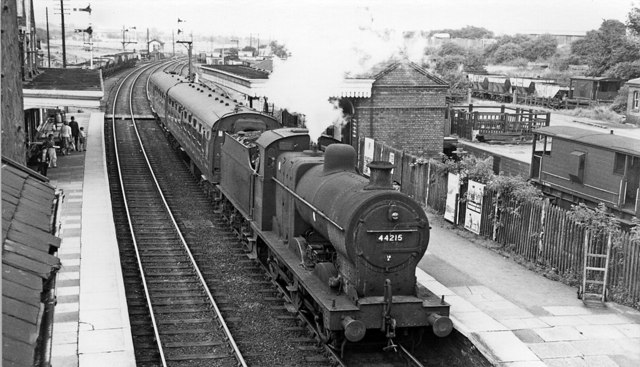
A Peterborough to Northampton to train at Wellingborough London Road Station © Copyright Ben Brooksbank under a Creative Commons Licence http://creativecommons.org/licenses/by-sa/2.0/ The line closed in 1964
By 1877 he had become editor of the Wellingborough News. But he life was cut short by a train crash. A Wellingborough local history site reports that in October 1877 he was badly injured in an accident on the Northampton to Peterborough railway line which killed two people and seriously wounded others. A passenger train was hit by a ballast train near Little Houghton. The carriage most badly damaged was carrying people returning from the Quarter Sessions (local court hearing). Supt Louis Poole, 42, of Wellingborough was killed instantly and his body thrown from the carriage. He left a widow and four children. Thomas Barrat, 30, a constable from Rothwell died after both legs were amputated, leaving a widow and one child. William Letherland editor of the Wellingborough News was badly injured and his spine was crushed. Letherland died two days after the crash. His death certificate described the cause of death as manslaughter. Later his wife, Priscilla, sought damages against the railway company and £1,250 was awarded to the family. Priscilla returned to live with her family in Radford, Nottingham. Their son, Herbert George Letherland, later became a chemist in Derbyshire.
John Leatherland : Died in a Gravel Pit in Welford
I came across a newspaper report from the London Gazette of Tuesday 9th June 1789 which reads as follows : Northampton, June 6. "On Tuesday as four men were at work in a gravel-pit near Welford, in this county, a large portion of earth at the mouth of the pit (supposed to be more than 50 loads) suddenly fell in upon them, Thomas Spriggs and John Leatherland. Assistance was immediately procured, and after digging about half an hour, Spriggs was fortunately discovered, and taken out nearly exhausted, but though much bruised, there are hopes of his recovery. Leatherland was not found till more than two hours had elapsed, of course too late to save his life. The Coroner's inquest sat on the body of the deceased, and brought in their verdict Accidental Death."
Poor John Leatherland was almost certainly one of my ancestors. I have not identified exactly where he fits in, although it seems likely that he was the "poor man" listed in the 1777 Militia List at Weedon.
John Letherland : Lieutenant Governor of the Isle of Man
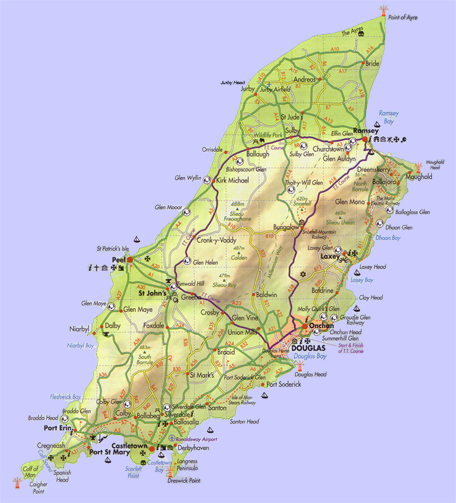
John Letherland (or Litherland) was governor of the Isle of Man in 1417. There is some evidence that he became Governor in 1405 . Almost all important officers of the Isle of Man during the 15th century were recruited from among the servants of the Stanley family of Lancashire. "The History of the House of Stanley" by John Seacombe refers to Sir John Stanley appointing John Letherland "a neighouring gentleman of Lancashire" who was a Justice of the Peace as Governor.
Pamela Leatherland : Actress
Miss Pamela Leatherland was an actress who appeared in theatre programmes for performances of Shakespeare's 'Measure for Measure' and 'Love's Labour's Lost' and Christopher Marlowe's 'The Tragical History of Doctor Faustus' at the Stratford upon Avon Memorial Theatre in 1947.
A year earlier Miss Leatherland wrote to my grandfather who was News Editor of the Daily Herald at the time. The drama critic of the paper contacted her to ask if she was related to him. She thought not but said that her relatives included a George Leatherland of Sheffield and a Harry Leatherland of Retford.
Thomas Leatherland : Transported to America
Thomas Leatherland of Northampton was reprieved from capital punishment in July 1862 and sentenced to transportation to America
[Details from a list of bonded passengers to the American Colonies, Midlands Circuit 1674 - 1775 quoted in the Northants Family History Society Journal Footprints July 1988]
Mary Lytherland: Innkeeper
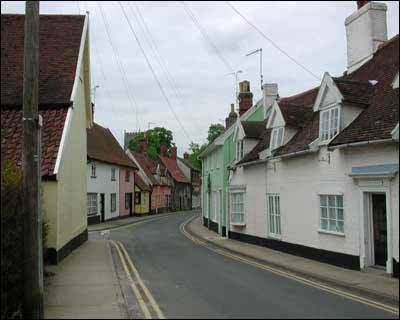
Castle St, Framlingham
Mary Lytherland was licensee of the Shoulder of Mutton Inn in Framlingham, Suffolk, in 1712 / 1713. [Source : case diary / entry book of Deveraux Edgar, an early eighteenth century Suffolk magistrate - information from David Knightly of Ipswich)
W. H . Leatherland : President of the TUC
W.H. Letherland was President of the Trades Union Congress (TUC) in 1872 held in Nottingham. He was elected to the Parliamentary Committee of the TUC in 1883. He was a silk thrower from Nottingham and president of a trade association in Nottingham.
Old Bailey Cases
There are three cases on the Old Bailey website involving Letherlands, two as victims and one as a criminal.
Case 1 : George Letherland was a sawyer who worked in Mr Territ's yard in Black-friars in London.
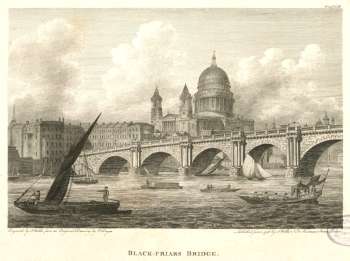
Blackfriars Bridge opened in 1769
On 9 April 1766 he gave evidence at the trial of Andrew Staffle who was charged with grand larceny for stealing a cloth coat worth 2 shillings which belonged to George Letherland. The defendant claimed to know nothing of the affair but was found guilty and sentenced to be whipped !
Case 2 : Samuel Letherland was a footman and valet in the service of William Villiers Stuart, a gentleman from a wealthy family who owned property in Ireland and later became an MP.
On 20 August 1838 Andrew Crawford Mitchell was tried for breaking into William Villiers Stuart's house at 19 St James's Place, London and stealing "two sheets, one table-cloth, three waistcoats, three coats, one pair of boots, one shawl, and a pair of trousers, all belonging to Samuel Letherland".
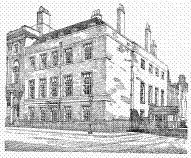
19 St James Place (later Cleveland House)
Eleanor Boyland was charged with receiving some of the stolen goods. Samuel Letherland gave evidence at the trial. Andrew Mitchell was found guilty and sentenced to transportation.
George Leatherland was accused of stealing four silk handkerchiefs worth 8 shillings from the shop of Holden Bouker. The trial took place in January 1741. The defendant claimed that he was incited to steal the handkerchiefs by the man who was with him, William Matthews. A witness said "I have known the Prisoner 15 or 16 Years, and always was an honest Man, as far as I knew".
A friend William Hill said that George Leatherland "followed the cow business".George's brothers, John Leatherland and Thomas Leatherland, both testified to his good character but he was found guilty and sentenced to transportation.
George was born in 1715 in Middlesex. He was the son of John Letherland who married Elizabeth Cook in St Annes Church, Soho in 1699. His wife Margaret Thomas was also originally from England, she emigrated to America in 1731 / 1732, possibly as a convict. They had two sons : John K Leitherland born 1750 and William Leitherland born 1752. George also had a brother, Edward Letherland born in 1713.
George Leatherlandwas transported to America in 1741 on the ship Speedwell, after a spell in Newgate Gaol. He settled in Maryland and married Margaret Thomas on Christmas Eve in 1748. He has American ancestors who have traced his family history - see Scott Leatherland's website www.theleatherlandproject.org
Mary Leatherland of Barbados
Her name appears on an immigration list to Barbados 1678.
Nathaniel Letherland : Master of the ship Penelope
Nathaniel Letherland appears on documents in the Calendar of State Papers Colonial, America and West Indies, Volume 37 - 1730, showing he was master of a ship, Penelope, which sailed from Maryland to Liverpool in 1727. [National Archives indexes]
Letherland - the Coiner
The State Papers Domestic for 1752 includes a petition of Elizabeth Taylor, wife of George Taylor, which says that a man called Leatherland, who lodged in her and her husband's house, was apprehended for coining (manufacturing, forging or using counterfeit coins or money.)
Leatherland and George Taylor were both put on trial at York Assizes. Leatherland was convicted as his confederate for having an edger and a coining press in his custody. The edger was proved to have been in Letherland's custody, and a coining press was said to have lain openly in a back kitchen for two years in sight of servants, although it was not believed to be a coining press by "Mr. Harris of the Mint", who went down to see it after the arrest.
The petitioner's husband had a good character, and said he knew nothing of coiners. The documents said that "the petitioner and her children must perish if he suffers death" . They sought pardon and reprieve.
Leatherland Gypsy Family Drowned in Tragic Accident
This is a very sad story. In St Mary’s churchyard, Hadlow, Kent there is a monument resembling an oasthouse. It marks the resting place of thirty hop pickers who were drowned in the River Medway at Hartlake on 20 October 1853. The victims range in age from 2 years old to 59 years old and included four children and several young girls. Twelve are thought to have been from Ireland while most of the rest were gypsies from one extended family.
Most of the drowned were Leatherlands : parents Samuel and Charlotte Leatherland, their daughters Comfort, Selina, and Alice Leatherland, and a daughter Lunia together with Lunia’s husband, John Herne and their two daughters. Sarah Taylor, her son and grandson, both named Thomas, and James Manser were related to the Leatherlands by marriage.
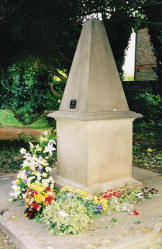
The Hop Picker's Memorial in Hadlow
The hop pickers were employed by a Mr Cox of Golden Green and were being taken by wagon to their camp site on the side of the river. One party had made the journey safely, but on the second trip one of the horses stumbled and the wagon hit the side of the wooden bridge, which gave way. The wagon, the passengers and the horses all fell into the river, which was swollen with flood water.
At the inquest, Fanny Leatherland described how the people came "tumbling down like hailstones". She managed to take hold of the harness of the hind horse and was saved. The verdict was that the deceased were accidentally drowned, due to the defective state of the road and bridge.
Funerals took place in St Mary’s over several days; the last on 14th November was of the two year old, daughter of Lunia and John Herne. Sadly no-one was left alive knew her Christian name. Those who died included :
Samuel Leatherland (59), Charlotte Leatherland (56), Comfort Leatherland (24), Selina Leatherland (22) and Alice Leatherland (18).
The Leatherlands and the other hop-pickers were from gyspy families. They were said to be related to an ancient gypsy family, the Hearns. According to the Romany Genes website, Samuel Leatherland is believed to have been the son of Elizabeth who married a Joseph Leatherland. Or Joseph may have been the brother of Elizabeth Leatherland who married Mullender Hearn. Gypsies often married the brothers’ or sisters’ of their partner. There are some complex family relationships, but as romany gypsies the Leatherland would have travelled widely.
www.romanyroad.co.uk the Romany Road website is the source of much of this information
“The bodies came tumbling upon me like hailstones” : The Inquest
A reporter from The Times newspaper visited the location of the accident and attended the coroner's inquest. Here is an extract from his report :
“The bridge is made of wood. It is 42 feet in length, and about 9 feet wide. It is called Hartlake- bridge and is built over the river Medway, near Golden-green in the parish of Hadlow, about five miles from Tunbridge. On each side of the bridge is a wooden fence or railing about three feet in height. This fence is evidently in a rotten state and the portions of it which have been broken in by the waggon or removed since may almost be crumbled into pieces by the hand. When the waggon containing the poor sufferers was descending the bridge – as will be seen by the evidence – one of the horses tripped or stumbled, the hind wheel broke the fence, and the earth next to it giving way, the waggon with the men, women and children, was dashed into the water. It contained about 40 persons. These persons were employed in hop-picking by Mr Cox, a gentleman living at Golders-green. That gentleman produced at the inquest a list of 30 persons employed by him, who are missing. Seven bodies had been found up to Saturday, so if that list be correct, of which there is little doubt, 37 persons have perished. As the river had overflowed in consequence of the heavy rains, the current was very rapid, and it is probable that the other bodies may have been washed a considerable difference.”
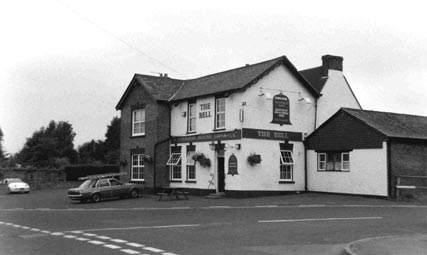
The Bell Inn, Golden Green
The inquest took place at the Bell Inn, Golden Green, Kent. The inquest jury visited the site of the accident. The coroner told them that they had to consider whether there had been gross negligence or wilful neglect by anyone amounting to manslaughter. The inquest heard evidence from 18 year old Dennis Collins who said that it was about 6.30 pm and dark when the waggon approached the bridge. The road was flooded with two feet of water. As they went over the bridge he said : “I heard a crash, but could not see at the moment what had happened. We were more than half over the bridge at the time. I was thrown into the water. The whole of the people and the waggon were thrown into the water. I saved myself by catching hold of a piece of the bridge, and some one assisted me.”
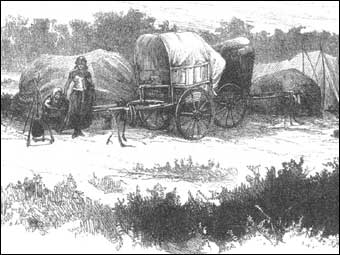
Fanny Leatherland also gave evidence to the Inquest : “Charlotte Leatherland was my mother. My mother and my father have both been drowned. My sister also. I had three sisters, a brother-in-law, and a little baby, who have not been found. I think there were 40 persons in the waggon. The waggon went over all at once. We had not time to say “Oh Lord!” before it was all over. I think the driver was sober. He was riding on the front horse. The water was not out where we tumbled over, but it was out at the foot of the bridge over the horses' knees. The driver could not walk on the side of the bridge on account of the water. Before the driver could pull up the horse's head the wheel touched the bridge, it broke down, and the waggon went into the water. The hind horse slipped, and the driver tried to pull the horse to the other side of the road. The wheel touched the paling of the bridge, broke the paling, and tipped over into the water. I don't think there was any fault on the part of the man. He could not help it. I should have been drowned if he had not told the men to pull me out of it. The horse was quiet. There was a great quantity of water coming down the river, and a very strong current, which swept all who were in the waggon into the river. The bodies came tumbling upon me like hailstones. I had hold of the waggon and then of the harness, and one of the men picked me up, I was in front of the waggon.
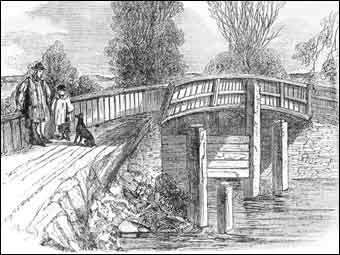
(Hartlake Bridge)
A further report in the Times a few days later said that ten more bodies were found soon after the inquest, and four more bodies were located after the river was dammed up by the Medway Navigation Company. The paper reported the burials of some of the deceased in Hadlow churchyard “where a large square grave had been dug and in which, three by three, the bodies were deposited”. Later that day five more bodies were interred in the same burial ground, including Samuel Leatherland, Charlotte Leatherland, Comfort Leatherland and Selina Leatherland, plus the body of another person “whose name was not ascertained”. The reporter commented that “this family belonged to the gypsy tribe”. He also reported that a 10 year old by managed to save himself by clinging on to part of the fence, and then catching hold of some osiers which were growing there. Although he then floated further down the river, he managed to grab some twigs and hold on to them until he was rescued.
The BBC Kent website has more information www.bbc.co.uk/kent/romany_roots/hartlake
There is a possible link between the Leatherlands who died in this accident and my Northants ancestors. A descendant of the Hearns who lives in Queensland, Australia has traced the marriage of Elizabeth Leatherland (born in Watford) to Mullender Hearn. Although Elizabeth could have been born in Watford, Herts, she may have been born in Watford, Northants which would link her to my Leatherland ancestors.
Elizabeth Leatherland : The Tring Centerian


Carte de Visite (photo mounted on card) of Elizabeth Leatherland reputedly in her 11th year
On 16th August 1873 a letter appeared in The Times newspaper from a correspondent in Leighton Buzzard recounting the tale of The Tring Centenarian, Elizabeth Leatherland who was reputedly 111 years old. The correspondent explained that Elizabeth had been baptised on 24th April 1763 at Chinnor, Oxon as 'Elizabeth, daughter of Thomas Horam, traveller' and that she was of gypsy parentage. The writer said that she married Joseph Leatherland a private in the Buckinghamshire Militia at St James Church, Dover in 1785 and that, after a few years settled in Dover, they resumed a nomadic travelling life until Joseph's death in about 1816 at Carrick-on-Shannon (in County Leitrim, Ireland). Following his death Elizabeth is said to have returned to Chinnor to live with an aged relative.
It is then reported that Betsy Leatherland's son William was killed in the Hadlow bridge disaster along with his wife and young children. Following the death of another relative with whom she had been living in 1860 [?], she sought a new home in Tring, Hertfordshire with relatives who had settled there. Her youngest daughter was said to have been a woman upwards of 70 now living at Chesham. For the last 11 years Betsy had been living with friends in Tring.
The correspondent reported that "Though decrepit and feeble, the old lady retains her faculties to a suprising degree : sight, hearing and speech are but slightly impaired. She is still able to employ herself in making nets, which are sold for her maintenance, and occasionally she will entertain her visitors with a snatch of song or carol of the olden times".
The writer admitted that most of this information came from the lips of Betsy Leatherland herself but that it is fully corroborated by the testimony of the oldest inhabitants of the neighbourhood. Some clearly doubted the veracity of the story and a few weeks later another letter appeared in The Times pointing out that the author of the original letter had produced little evidence and no details of Betsy Leatherland's daughter and challenging the author to supply information such as details of her parents and siblings to enable a conclusion to be reached on whether she was really 111 years old.
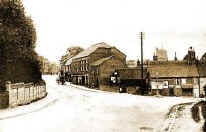
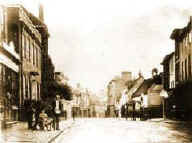
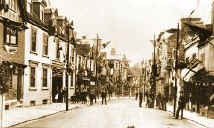
The following year (1874) The Times reported that Elizabeth Leatherland the Tring Centenarian had died at the age of 112. As evidence of her age, the paper referred to an old man buried in the churchyard at Tring at the age of 93 who had always maintained that Besty was about 10 years older than him and that he knew her when she was a girl. The reporter said that he had met her daughter (the only surviving child) who told him that her grandmother had died in childbirth at Chinnor and that the family name was also known as Hearn as well as Horam. The daughter said that the Hearn family was well known in Hertfordshire, Buckinghamshire and Oxfordshire as travelling gypsies. However some doubt was cast on the centenarian claims because the Rector of Chinnor had checked the parish registers and found no reference to the baptism of Elizabeth Horam or Hearn or any similar name in 1763 or indeed up to 1800. A doctor examined Elizabeth Leatherland a year or two before her death and after her death and found none of the usual signs of decay that would be expected in a centenarian. The doctor had declared that her heart and lungs were 'in almost perfect condition' and that her skin ' was as soft and smooth as velvet'. The reporter concluded (with great fairness) that "though it is probably impossible to prove the exact age of Elizabeth Leatherland, so as to satisfy the demands of evidence, there is little ground for doubting she was a centenarian, and that it will never be proved she was not 112".
The Evidence :
There is a death registered aged 111, but you do not need to supply evidence of age when registering a death. I can't find Elizabeth in the 1841 / 1851 / 1861 or 1871 censuses in Hertfordshire or indeed anywhere else under the surname Leatherland, but gypsies and travellers do not always appear in the census. However there is a baptism of Elizabeth Hearn in the IGI in Thame parish on 23 December 1763, daughter of Thomas and Elizabeth Hearne. Chinnor was a separate parish but is only four miles from Thame. So this seems to corrobate the story. (I also noted several other Hearn baptisms in Thame between 1753 and 1771 all to Thos and Elizabeth Hearn and all the children were baptised as Betsy / Elizabeth but most are noted as having died in infancy).
William Leatherland : Gentleman Builder of Warwick
William Leatherland was probably baptised in Radford Semele, Warwickshire, son of Joseph and Mary Leatherland. Pigot`s Directory (1828-1829) listed him as a builder in Gerrard Street, Warwick.
The Warwicks Quarter Sessions index for 1827 mentions William Leatherland of Warwick as the victim of a theft in Warwick.
William married Mary Taylor in around 1832. As far as I am aware they had no children. We know he was living in St John's Street, Warwick in 1837 as he was a signatory to a testimonial to the former Town Clerk of Warwick (Leamington Spa Courier & Warwickshire Courier). The 1841 census lists him aged 45 in Cotton End, St Nicholas, Warwick, occupation builder.
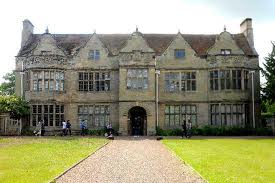
St John's House, Warwick, now the Royal Wawickshire Regimental Museum
William died in 1850 at the age of 62. A Warkwickshire newspaper reported his death and described him as a "Gentleman of the Borough of Warwick". He left a will which divided his estate among relatives. The bulk of his estate went to his nephews : Joseph Leatherland, a carpenter of Eastcote, near Knowle and William Gardner of Bethnal Green, London. Annuities were given to his sisters Ann and Dinah and he mentions his brother, John Leatherland. Other monies were left to his wife`s nephews. His death certificate also describes him as a Gentleman, residing at Cotton End, Warwick.
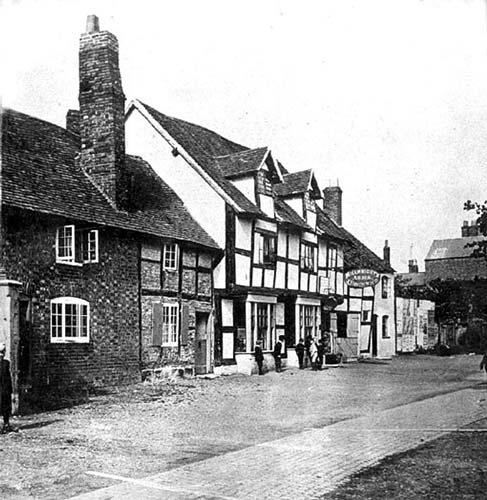
(Coten End in the 1890s)
Cotton End (now called Coton End) is a road in the east end of Warwick described in 1815 as being "a wide street, principally inhabited by the more laborious, but not the least useful, class of the community" [in An Historical and Descriptive Account of the Town and Castle of Warwick" - William Field - 1815]
How a builder became a gentleman is not clear, but William must have made his fortune in that trade, and his wealth no doubt helped to shape his image.
William's nephew Joseph Leatherland was a carpenter in Warwickshire who no doubt helped his uncle in the building trade. In his later years he became a farmer. The 1861 census described him as a farmer of 12 acres living at Knowle Common. By 1871 he was an 'occupier of land'. Following the death of his first wife he remarried in his late sixties. When Joseph died in 1884 he left a Will which described him as a Gentleman. He left £20, all his household goods and a life interest to his wife Sarah, 5 shillings per week to Hannah Parsons widow of William Parsons late of Cogleton, Chesire, and following death of his wife and Hannah Parsons, his estate was to be divided between builder friends in Liverpool some of whom were executors. His gross personal estate was £713.
Edward Leatherland : Army Colonel
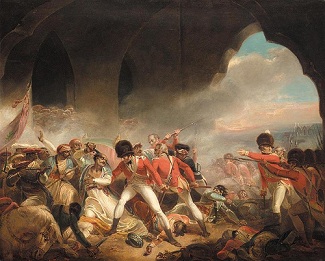
Edward Letherland was an army officer who became Colonel of the 10th Regiment of Foot (the 10th Lincolnshire Regiment). The regiment was raised in Ireland. It was dispatched to India and fought in the Second Anglo-Mysore War. After surrendering in May 1783, it was interned before returning to Ireland in 1784..
Letherland's career from Lieutenant in 1791, to Captain of an Independent Company of Foot in 1793, to Captain in 1795 and then promotion to Major can be traced from notices in the London Gazette.
The National Archives indexes list among the papers of the Feilding family of Newnham Paddox, Warwickshire a letter to Edward Leatherland at Bates' Hotel Adelphi, London from William Robert Viscount Feilding who was a Major General in the Army.
William Leatherland : Member of the Winthrop Fleet
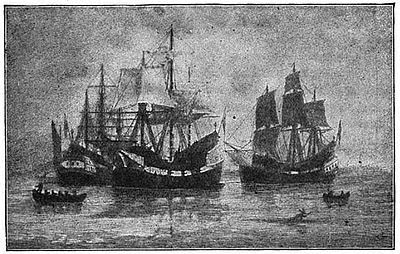
William Leatherland was a member of the Winthrop Fleet, a group of 11 ships led by John Winthrop which carried around 700 Puritans together with livestock and provisions from the Isle of Wight, England to New England during the spring and summer of 1630, as part of the Great Migration to America between 1620 and 1640. They founded the Massachusetts Bay Colony.
William was born in 1608. His origins are not certain but it is believed that he came from London. Some sources say that he was the servant of Owen Rowe, a silk merchant of All Hallows, Honey Lane, in London. William was a carpenter. He settled in Boston, Massachusetts. He married Margaret and had a child Zebulon
The www.newenglandancestors.org database lists various references to William, with several variations of the surname. For example, The Records of the First Church in Boston (1630-1868, Publications of the Colonial Society of Massachusetts) refer to "Willyan Letherland one of Mr. Roe's men servants" being admitted to the Boston church in 1633.
On 20 November 1637 he was one of the Boston men to be disarmed as a supporter of Wheelwright [Records of the Governor and Company of the Massachusetts Bay in New England, 1628-1686].
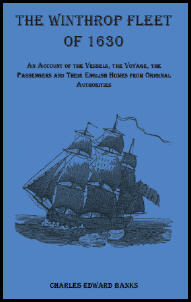
It seems that William was not a model citizen. The Records of the First Boston Church say that on 6th July 1645 "Our brother Willyam Lytherland (though absent from the Church and not coming thereunto being sent unto by one of the Elders in word of mouth by our brother Mr. Willyam Harding) was with the consent of the Church by their silence (they being then assembled together) by the Elder Mr. Leveritt in the power of the Lord Jesus Christ cast out of the Church for the crime confessed in his letter to the Church, namely for committing adultery with his maid-servant, by whom he hath had a base child thereupon". (It seems that William had gone up in the world as he had a maid servant). Sixteen years later in 1661 he was admitted back into the church. The document which refers to this gives his name as Willyam Leatherland.
William seems to have fallen into bad habits again. On 8 February 1670 the Records of the First Boston Church say that "Our Brother Willyam Leatherland for drunkenness was excommunicate[d]". But four years later in 1674 "Our brother William Letherland was released from excommunication and restored unto Communion" . William, by now aged 74, slipped again and on 25 July 1680 the First Boston Church records show that "William Letherland [was] excommunicated for drunkenness by sign of hand lifted up".
The New England Ancestors database shows that William acted as a General Recorder for Rhode Island General Court at various times mainly in the 1650s. He was town clerk at Newport in 1652 and 1653 and commissioner to Rhode Island General Court for Newport from 1654-1656.
The Boston Book of Possessions (1645) says that William Letherland owned one house and a lot. The Records of the Colony of Rhode Island and Providence Plantations (1636-1692) refer to a petition by "William Lytherland" for money due him from the colony. Three men were appointed to audit his accounts. He received £5 13 s 2d.
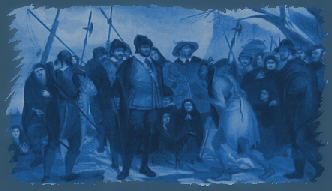
According to a volume of the Suffolk Deeds in 1660 a man called Richard Gridley, aged about fifty-nine years, gave a deposition saying that . . . .
"about thirteen years since I heard William Leatherland say that he would give unto Nathaniell Patridge the one half of the house he then lived in near unto the water's side with half the ground belonging to it ... he ... called William Dening and myself to bear witness that he did give the abovesaid half his house and half his lot unto Nathaniell Patridge and his wife the sister of the abovesaid Leatherland and at that time both William Leatherland and his wife in our presence gave up their right and interest in that part of the house and land ... and desired us in a solemn manner to bear witness to it and they gave this reason why they so gave it because the wife of the said Nathaniell was William Leatherland's own sister and also for the service she did them when she was a maid & in relation unto her marriage with the said Nath. Patridge".
This evidence shows that William had a sister, Ellen, who married Nathaniel Partridge.
The Suffolk Deeds records also say that on 5 February 1662/3 :
"William Letherland of Boston ... carpenter & Margaret his wife sold to Peter Tyll of Boston, sawyer, for a valuable sum a parcel of land in Boston six rods and eleven feet long and four rods wide, bounded east by the said William Letherland, south by Abel Porter, west by the highway, and north by Henry Allin and Richard Gridley, reserving to William Letherland a highway five feet wide "between the above specified land hereby bargained & sold and the ground which the said Henry Allen & Richard Gridley bought of the said William Letherland; Margaret Leatherland relinquished her dower rights on 6 May 1663 when Nathaniel Partridge married William Leatherland's sister, Ellen"
William married Margaret sometime between 1634 and 1647. It appears that she had been married before because the Records of the First Church in Boston say that she was the mother of a daughter Elizabeth, who married about 1643 George Orris of Boston, blacksmith, and who deposed regarding her father-in-law having married her mother sometime after 1634.
William Leatherland was imprisoned in 1763 by an execution from the Salem Court . He was committed to prison in Boston for nonpayment of a debt. From prison he petitioned Mr. William Browne, his creditor, on 14 September 1674, saying :
"you know the debt is not mine & that I have a bond to keep me indemnified.... I told you before you kept me on the tainters by omission endangering me & my posterity, & now where am I ! In prison deprived of public ordinances from way of subsistence for my sick wife & self, her said deprival of help lying (as supposed) on her deathbed will lie at somebody's door, as also my rotting in prison ... but what am I imprisoned for, for a judgement against me who never dealt with you for or about one penniworth of anything".
On 27th October 1674 William Leatherland petitioned repeatedly from Boston prison to be allowed to visit his very sick wife.
His various petitions extended for many pages and included a legal note that "[Lytherland is] no stranger for he hath been here about forty-four years & a freeman of this jurisdiction about forty years..." . The editor of the Suffolk County Court records (which were published by the Colonial Society of Massachussetts in 1933) says that "The Court of Assistants reversed the judgment of the lower court in spite of a moving petition to them from Lytherland, recalling his friendship with Elder Leverett the Governor's father and other 'ancient brethren & sisters'". "Lytherland" sued the clerk at Salem, Hilliard Veren, for illegally writing the execution that sent him to prison, but the court found in favour of Hilliard Veren.
His son, Zebulon, is thought to have been born by or before 1650 (as the Records of the Suffolk County Court show him to be an adult by 1671). The New England Ancestors Project thinks he was probably born earlier based on the estimated date of marriage. It also says that it is possible that he was Leatherland's "base-born" (illegitimate) child with his maid servant as his wife Margaret would appear to have been too old.
It seems a case of "like father like son" as the records of the Suffolk County Court say that on 30th January 1671/2, both William Letherland and 'Zebeon' Letherland were convicted for excessive drinking and fined by the court.
On 26 August 1678, 57 year old Elizabeth Orris deposed that about "forty-four years ago the land whereon my father-in-law William Lytherland now dwelleth with all the land southward and all the beach before it was his ... and I dwelling with old Goodman Grubb ... I do know that some time after that my father-in-law was married to my own mother and he understanding that my master was to give me a house when my time was out, he then gave to my master Grubb that slip of land without his fence from the fish house by a line to the corner post of his planting ground, reserving to himself the other part both of the ground and beach, with the intent that my master Grubb should build my promised house upon the aforesaid slip of land then to enlarge it unto me out of his other land, as both himself and my mother have often informed me" . [This suggests that Elizabeth married Zebulon but why was she called Orris ?]
In June 1684 "William Lytherland aged about seventy-six years" deposed with others, "being ancient dwellers and inhabitants of the town of Boston in New England from the time of the first planting and settling thereof and continuing so at this day," regarding the sale of land by Mr. William Blackstone in or about 1634.
Elizabeth Leatherland of Providence, Rhode Island
Elizabeth Leatherland crops up in many American family histories and trees. She is said to have been born in about 1619 in Providence, Rhode Island or according to other sources she was born in England in about 1613.
Many sources say that she married Thomas Harris in 1632 who was born in 1605 in Milford, Wales. She died in 1687 in Providence, Rhode Island a year after Thomas died.
A note of caution is sounded by the excellent www.harrisfamilynews.com website which explains that, although Thomas Harris married a lady called Elizabeth, it is not certain that he married Elizabeth Leatherland. Further research was carried out by the New England Historic Genealogical Society in 2008. This research shows that
(a) there are at least two Thomas Harris who emigrated to England to America
(b) one Thomas Harris emigrated in 1632 with his wife Elizabeth (maiden name unknown)
(c) another Thomas Harris emigrated unmarried in 1637.
It also casts doubt on the claim that Thomas Harris married Elizabeth Leatherland in 1832 in Providence, Rhode Island not least because Providence was not settled until 1636.
The New England Historic Genealogical Society tried to establish whether Elizabeth Leatherland was related to the William Leatherland who settled in Boston. Although William's wife, Margaret, already had a child Elizabeth when they married, it is unclear whether this child would have taken the surname Leatherland when her mother married. The evidence suggests that this Elizabeth is not the Elizabeth who married Thomas Harris.
Wanted ! William Leverland of Calne Wilts: Criminal ?
My uncle found a Proclamation for the arrest of William Leverland of Calne in Wiltshire. It dates from 1746 and relates to a complaint made to the House of Commons, at the request of officials of the borough of Calne in Wiltshire, that an undue attempt had been made to influence them in giving their votes for a Member of Parliament by the promise of fifteen hundred pounds as a bribe by William Leverland. Leverland then went on the run.
London Leatherlands
There are a handful of Leatherlands / Litherlands who appear in historical records in London, especially in the early modern period (16th - 18th centuries). The name is still rare there, but it does crop up.
For example the London Apprenticeship Abstracts (1442 to 1850) list 12 references to the name. The Apprenticeship Abstracts are taken from the records of the Livery Companies of London. They provide information from the apprenticeship records of a number of the livery companies and generally give good genealogical details, such as the name, parish and occupation of the apprentice's father. The records can be searched on the www.origins.net website which has a database of over 165,000 record abstracts with over 500,000 names of apprentices, their parents, and their masters indexed.
In nearly every case the name of the father of the apprentice is given, with their place of residence - which can be anywhere in the UK or overseas. It is interesting to note that less than 30% of the “London” apprentices actually came from the London area.
Here is what I found :
- 1589 - Henry Letherlande, son of Robert, Lancashire, husbandman, to William Kenneng, 25 Dec 1589, Plumbers' Company
- 1590 - William Letherland, son of Robert, Warton, Lancashire, husbandman, to Thomas Sympson, 25 Dec 1590, Plumbers' Company
- 1610 - Francis Whithorne [William in a/c] son of Richard, Foxcote, Withington, Gloucesterhire, yeoman to Zachariah Letherland, 4 Dec 1610, Vintners' Company
- 1614 - William Saunby, son of Francis, Streatham, Surrey, yeoman to Zachary Letherland, 5 Sep 1614, Vintners' Company
- 1619 - John Pettit, to Zachary Letherland, 1 Sep 1619, Vintners' Company
- 1619 - Robert Gove, to Zachary Letherland, 5 May 1619, Vintners' Company
- 1625 - William Letherland, son of Nicholas, Westminster, Middlesex, glazier to John Titley, 6 Apr 1625, Vintners' Company
- 1627 - Robert Letherland, son of Edmund, Swannington [Whitwick], Leicestershire, husbandman, to John Jenkinson, 2 Oct 1627, Brewers' Company
- 1669 - Thomas Leatherland, son of John, Warrington, Lancashire, innholder, to John Bowden, 16 Feb 1668/9, Painters' Company
- 1682 - Joseph Browne, son of Joseph, Gloucester, Gloucestershire, mercer, to Thomas Leatherman, 6 Sep 1682, Painters' Company
- 1693 - Francis Adams, son of Thomas, Little Horwood, Buckinghamshire, farmer, to Thomas Litherland, 1 Mar 1692/3, Painters' Company
- 1724 - Thomas Leatherland, son of John, Soho, Middlesex, wheelwright, to Anthony Durrham, 29 Oct 1724, Plaisterers' Company
Zachary Leatherland was a Master in the Vintner's Company who had several apprentices at various times. The Vintners Company has an ancient history and was involved in the wine trade. I was surprised to discover that the wine trade was of huge importance to the medieval economy in Britain and that, for example, between 1446 and 1448, wine made up nearly one-third of England's entire import trade !! We were clearly a nation of alcoholics 600 years ago . . .
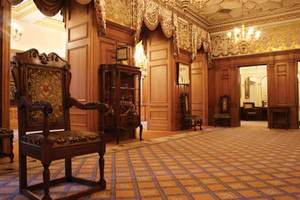
The Drawing Room of Vintners Hall, London
Many of the apprentices travelled long distances to become apprenticed in London - for example three of the Leatherland apprentices came from Lancashire, a 200 mile journey ! This sheds new light on the idea that our ancestors tended to remain in the same areas for most of their lives.
Zachary Leatherland crops up in other records. The Boyds Inhabitants of London Index, a 237 volume index created by Percival Boyd between 1939 and 1944 from his study of various books, catalogues and manuscripts held in the Library of the Society of Genealogists.
The Boyd index lists Zachary Leatherland in 1611 / 1612 living in All Hallows, Bread Street, profession vintner, and gives the names of his six children : Zachary, John, Margery , Jane, Chrisom and Ann Leatherland all born and baptised between 1612 and 1618. Bread Street is in the City of London, near St Pauls.
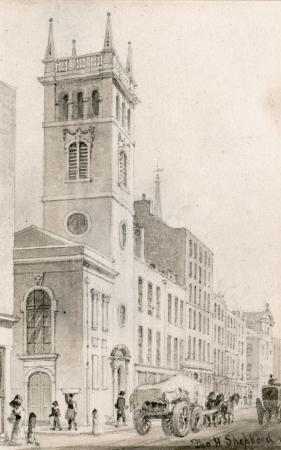
All Hallows Church, Bread Street (painted by artist Thomas Hosner Shepherd)
Another much more obscure reference from London comes from the abstract of a will made in 1639 by a man called Gilbert Springbett of St Saviour Southwark, a waterman. Among the legacies in his will, he left 10 shillings and "all the wearing clothes belonging to Elizabeth Latherland, deceased" to his cousin Cicely Letts. Odd that he would bequeath the clothes of a woman who had died to a cousin ! There is no evidence in the abtract of the will what Elizabeth Latherland's relationship to Gilbert Springett was. [Source : Surrey & South London Will Abstracts 1470-1856]
Ernest Letherland : Olympic Marathon Runner
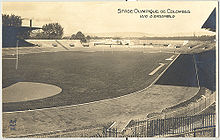
The Stade Olympique de Colombes in Paris which hosted the opening ceremony and several sporting events in the 1924 Olympics.
Ernest Letherland was a British athlete who competed in the Marathon in the 1924 Olympics in Paris. Fifty-eight runners from twenty nations took part . Only thirty finished the race and Letherland was not one of those .
Ernie Letherland was an athlete from Bulwell, Nottingham. He was the son of Joseph Leatherland, who was a paper merchant in 1901 when the family were living in Failsworth, near Manchester. By 1911 Ernest's family was back in Nottinghamshire, living in Babbington. Ernest was 16 years old and working as a paper bag maker, probably with his father who gave the same occupation. His mother had died.
He was 30 years old when he competed in the Olympics. He won the Northern marathon in 1923 and 1924, came third in the 1928 Poly race, and finished third in the AAA marathon in 1929.
[Information from www.sports-reference.com]
Henry Lytherland : The Priest Who Defied the King
Henry Lytherland was a priest who was executed in York in 1538. For thirteen years he was legal adviser to Lincoln Cathedral. He was educated at Oxford University studying civil and canon law. From 1514 to 1529 he was vicar at Pattishall, Northamptonshire. 
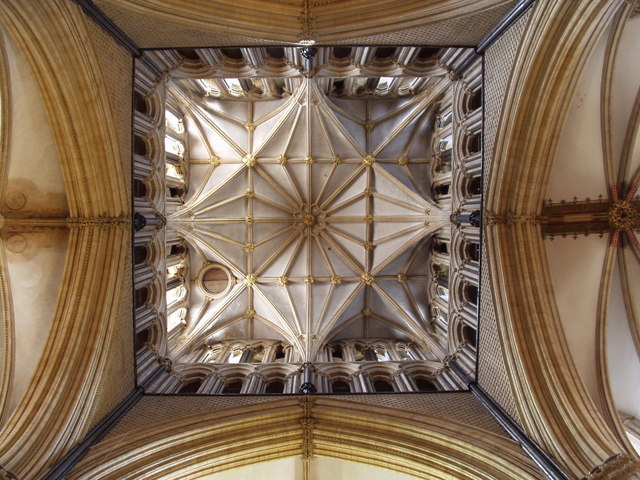
Lincoln Cathedral : looking up to the tower © Copyright Bill Booth and licensed for reuse under a Creative Commons Licence
Father Lytherland preached a surmon in Newark church in 1534 which was unfavourable to the supremacy of King Henry VIII. He was charged with treason. He was around 50 years old when he was executed.
(Information from the booklet "The Priest Who Defied the King" by MJ Carty 2007)
Edward Letherland : Headmaster
Edward Letherland M.A. was Headmaster of Repton School, a public school in Derbyshire, from 1672 to 1681. Repton School was founded in 1557 and stands on the site of a 12th Century Augustinian Priory.
(Source : "Historical and topographical description of Repton, in the county of Derby" By Robert Bigsby via Wikipedia)
Oddly (perhaps) Repton now has a twin : Repton School in Dubai, said to be the first boarding school in the Middle East.
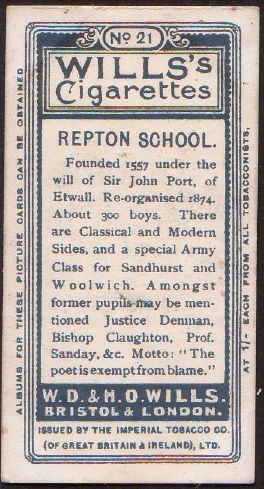
Wills's Cigarette Card 1906
Joseph and Sarah Leatherland - Bedford Prisoners
A Victorian Crime and Punishment website includes details of prisoners from Bedford prison records. Joseph Leatherland of Bedford appears in the records because he was accused of stealing linen in 1833 when he was 23 years old. He was tried at the Lent Assizes although the outcome is not indicated. The records give a physical description of the prisoner and we learn that Joseph was 5'8", with light brown hair and a pale complexion.
Sarah Leatherland was accused of the same offence. She was possibly Joseph's wife or his sister. She was 30 years old, 5' tall with dark hair. In Sarah's case we know the sentence she received which was 9 months' hard labour.
Joe Leatherland - Folk Guitarist
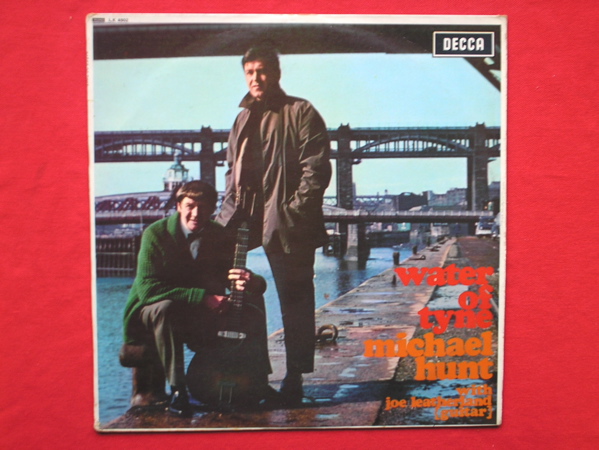
Joe Leatherland played guitar and appeared on Michael Hunt's album Waters of Tyne, released on Decca in 1967. I don't know very much about Joe, but he was clearly a Geordie and the album appears to consists of traditional Geordie folk songs, including 'Wor Nanny's a Mazer', 'Buy Broom Buzzems' and 'Keep Your Feet Still Geordie Hinny'. Where are you now, Joe ?
Contemporary Leatherlands
A note about some contemporary Leatherlands with various claims to fame. I don't know about their family history but perhaps if any of them are reading this, they can enlighten me.
Stephen Leatherland is a leading theatre director and producer who began his career as an actor. Stephen grew up in Derbyshire.
Professor John F. Leatherland is an academic at Ontario Veterinary College, University of Guelphn Canada an expert on the hormonal control of early development of fish and the author of many books and articles on fish diseases and development. Professor Leatherland graduated at Sheffield University (UK).
David Richards
E-mail : davidr4u@btinternet.com